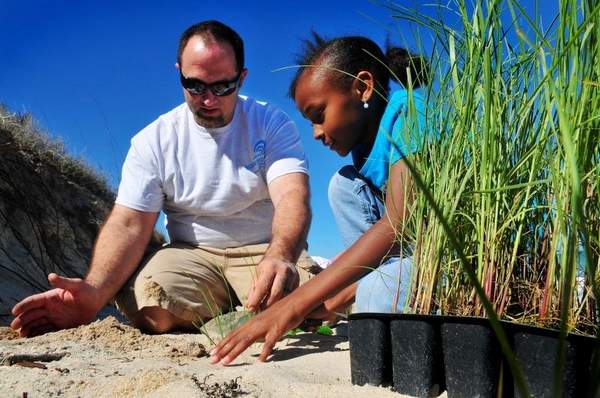Government Grants
Business Grants
Home Owner Programs
Federal Programs
About Us
GRID RELIABILITY WITH AUTOMATIC DAMPING AND INERTIA FOR ELECTRICAL NETWORKS AND TRANSMISSION SYSTEMS SBIR/STTR (GRADIENTS SBIR/STTR)
DE-FOA-0003555 - GRID RELIABILITY WITH AUTOMATIC DAMPING AND INERTIA FOR ELECTRICAL NETWORKS AND TRANSMISSION SYSTEMS SBIR/STTR (GRADIENTS SBIR/STTR) To obtain a copy of the Notice of Funding Opportunity (NOFO) please go to ARPA-E eXCHANGE at https://arpa-e-foa.energy.gov.
To apply to this NOFO, Applicants must register with and submit application materials through ARPA-E eXCHANGE (https://arpa-e-foa.energy.gov/Registration.aspx).
For detailed guidance on using ARPA-E eXCHANGE, please refer to the ARPA-E eXCHANGE User Guide (https://arpa-e-foa.energy.gov/Manuals.aspx).
ARPA-E will not review or consider application materials submitted through other means.
For problems with ARPA-E eXCHANGE, email ExchangeHelp@hq.doe.gov (with NOFO name and number in the subject line).
Questions about this NOFO? Check the Frequently Asked Questions available at http://arpa-e.energy.gov/faq.
For questions that have not already been answered, email ARPA-E-CO@hq.doe.gov.
Agency Overview:
The Advanced Research Projects Agency – Energy (ARPA-E), an organization within the Department of Energy (DOE), is chartered by Congress in the America COMPETES Act of 2007 (P.L.
110-69), as amended by the America COMPETES Reauthorization Act of 2010 (P.L.
111-358), as further amended by the Energy Act of 2020 (P.L.
116-260):
“(A) to enhance the economic and energy security of the United States through the development of energy technologies that— (i) reduce imports of energy from foreign sources; (ii) reduce energy-related emissions, including greenhouse gases; (iii) improve the energy efficiency of all economic sectors; (iv) provide transformative solutions to improve the management, clean-up, and disposal of radioactive waste and spent nuclear fuel; and (v) improve the resilience, reliability, and security of infrastructure to produce, deliver, and store energy; and (B) to ensure that the United States maintains a technological lead in developing and deploying advanced energy technologies.” ARPA-E issues this Notice of Funding Opportunity (NOFO) under its authorizing statute codified at 42 U.S.C.
§ 1653 8. The NOFO and any cooperative agreements or grants made under this NOFO are subject to 2 C.F.R.
Part 200 as supplemented by 2 C.F.R.
Part 91 0. ARPA-E funds research on, and the development of, transformative science and technology solutions to address the energy and environmental missions of the Department.
The agency focuses on technologies that can be meaningfully advanced with a modest investment over a defined period of time in order to catalyze the translation from scientific discovery to early-stage technology.
For the latest news and information about ARPA-E, its programs and the research projects currently supported, see:
http://arpa-e.energy.gov/.
ARPA-E funds transformational research.
Existing energy technologies generally progress on established “learning curves” where refinements to a technology and the economies of scale that accrue as manufacturing and distribution develop drive improvements to the cost/performance metric in a gradual fashion.
This continual improvement of a technology is important to its increased commercial deployment and is appropriately the focus of the private sector or the applied technology offices within DOE.
In contrast, ARPA-E supports transformative research that has the potential to create fundamentally new learning curves.
ARPA-E technology projects typically start with cost/performance estimates well above the level of an incumbent technology.
Given the high risk inherent in these projects, many will fail to progress, but some may succeed in generating a new learning curve with a projected cost/performance metric that is significantly better than that of the incumbent technology.
ARPA-E will provide support at the highest funding level only for submissions with significant technology risk, aggressive timetables, and careful management and mitigation of the associated risks.
ARPA-E funds technology with the potential to be disruptive in the marketplace.
The mere creation of a new learning curve does not ensure market penetration.
Rather, the ultimate value of a technology is determined by the marketplace, and impactful technologies ultimately become disruptive – that is, they are widely adopted and displace existing technologies from the marketplace or create entirely new markets.
ARPA-E understands that definitive proof of market disruption takes time, particularly for energy technologies.
Therefore, ARPA-E funds the development of technologies that, if technically successful, have clear disruptive potential, e.g., by demonstrating capability for manufacturing at competitive cost and deployment at scale.
ARPA-E funds applied research and development (R&D).
The Office of Management and Budget defines “applied research” as an “original investigation undertaken in order to acquire new knowledge…directed primarily towards a specific practical aim or objective” and defines “experimental development” as “creative and systematic work, drawing on knowledge gained from research and practical experience, which is directed at producing new products or processes or improving existing products or processes.” Applicants interested in receiving financial assistance for basic research (defined by the Office of Management and Budget as “experimental or theoretical work undertaken primarily to acquire new knowledge of the underlying foundations of phenomena and observable facts”) should contact the DOE’s Office of Science (http://science.energy.gov/).
Office of Science national scientific user facilities (http://science.energy.gov/user-facilities/) are open to all researchers, including ARPA-E Applicants and awardees.
These facilities provide advanced tools of modern science including accelerators, colliders, supercomputers, light sources and neutron sources, as well as facilities for studying the nanoworld, the environment, and the atmosphere.
Projects focused on early-stage R&D for the improvement of technology along defined roadmaps may be more appropriate for support through the DOE applied energy offices including:
the Office of Energy Efficiency and Renewable Energy (http://www.eere.energy.gov/), the Office of Fossil Energy and Carbon Management (https://www.energy.gov/fecm/office-fossil-energy-and-carbon-management), the Office of Nuclear Energy (http://www.energy.gov/ne/office-nuclear-energy), and the Office of Electricity (https://www.energy.gov/oe/office-electricity).
ARPA-E encourages submissions stemming from ideas that still require proof-of-concept R&D efforts as well as those for which some proof-of-concept demonstration already exists.
Submissions can propose a project with the end deliverable being an extremely creative, but partial solution.
Program Overview:
The Grid Reliability with Automatic Damping and Inertia for Electrical Networks and Transmission Systems (GRADIENTS) program will support the development of disruptive grid assets and control solutions enabling renewable energy systems to provide and improve services traditionally supported by large conventional synchronous generators.
At present, existing renewable energy systems without ancillary services can deteriorate grid stability.
This program aims to use real-time control co-design (RT-CCD) to transform that problem into a solution, specifically creating intelligent inverter-based resources (IBRs) that improve grid controllability and coordination.
The RT-CCD methodology uses control engineering principles throughout the design process rather than considering control design as a subsequent process.
By co-optimizing assets for power delivery and controllability, this design methodology can achieve improvements in grid stability that are not otherwise possible without prohibitive capital expenses.
Projects in this program will cover technologies in three categories:
flexible renewable generation, intelligent automatic relays, and wide-area RT-CCD.
GRADIENTS technologies based on dynamic metrics that quantify grid stability and controllability in terms of rate of change of frequency (RoCoF), nadir, decay ratio, and recovery time, and the program will also include a techno-economic metric for synergy margin evaluation.
The program will drive advancements in grid resilience, efficiency, and adaptability.
By addressing and coordinating resources that can provide inertia (energy) and damping (control) with fast frequency regulation across the grid, GRADIENTS will improve reliability in high-renewable penetration scenarios, mitigating blackout risks, reducing potential curtailment of renewables, lowering operational costs, and maximizing economic viability.
The program will also foster technological innovation by developing intelligent relays and fault-tolerant protection systems, improving fault detection, adaptability, and response capabilities tailored for IBRs.
Furthermore, its scalable and flexible approach to distributed control supports a wide range of applications from large regional grids to localized microgrids with customization for diverse energy mixes and regulatory requirements.
Collectively, these advancements will modernize grid infrastructure, promote renewable energy integration, improve grid dynamics, and support a sustainable energy future.
To view the NOFO in its entirety, please visit https://arpa-e-foa.energy.gov.
To apply to this NOFO, Applicants must register with and submit application materials through ARPA-E eXCHANGE (https://arpa-e-foa.energy.gov/Registration.aspx).
For detailed guidance on using ARPA-E eXCHANGE, please refer to the ARPA-E eXCHANGE User Guide (https://arpa-e-foa.energy.gov/Manuals.aspx).
ARPA-E will not review or consider application materials submitted through other means.
For problems with ARPA-E eXCHANGE, email ExchangeHelp@hq.doe.gov (with NOFO name and number in the subject line).
Questions about this NOFO? Check the Frequently Asked Questions available at http://arpa-e.energy.gov/faq.
For questions that have not already been answered, email ARPA-E-CO@hq.doe.gov.
Agency Overview:
The Advanced Research Projects Agency – Energy (ARPA-E), an organization within the Department of Energy (DOE), is chartered by Congress in the America COMPETES Act of 2007 (P.L.
110-69), as amended by the America COMPETES Reauthorization Act of 2010 (P.L.
111-358), as further amended by the Energy Act of 2020 (P.L.
116-260):
“(A) to enhance the economic and energy security of the United States through the development of energy technologies that— (i) reduce imports of energy from foreign sources; (ii) reduce energy-related emissions, including greenhouse gases; (iii) improve the energy efficiency of all economic sectors; (iv) provide transformative solutions to improve the management, clean-up, and disposal of radioactive waste and spent nuclear fuel; and (v) improve the resilience, reliability, and security of infrastructure to produce, deliver, and store energy; and (B) to ensure that the United States maintains a technological lead in developing and deploying advanced energy technologies.” ARPA-E issues this Notice of Funding Opportunity (NOFO) under its authorizing statute codified at 42 U.S.C.
§ 1653 8. The NOFO and any cooperative agreements or grants made under this NOFO are subject to 2 C.F.R.
Part 200 as supplemented by 2 C.F.R.
Part 91 0. ARPA-E funds research on, and the development of, transformative science and technology solutions to address the energy and environmental missions of the Department.
The agency focuses on technologies that can be meaningfully advanced with a modest investment over a defined period of time in order to catalyze the translation from scientific discovery to early-stage technology.
For the latest news and information about ARPA-E, its programs and the research projects currently supported, see:
http://arpa-e.energy.gov/.
ARPA-E funds transformational research.
Existing energy technologies generally progress on established “learning curves” where refinements to a technology and the economies of scale that accrue as manufacturing and distribution develop drive improvements to the cost/performance metric in a gradual fashion.
This continual improvement of a technology is important to its increased commercial deployment and is appropriately the focus of the private sector or the applied technology offices within DOE.
In contrast, ARPA-E supports transformative research that has the potential to create fundamentally new learning curves.
ARPA-E technology projects typically start with cost/performance estimates well above the level of an incumbent technology.
Given the high risk inherent in these projects, many will fail to progress, but some may succeed in generating a new learning curve with a projected cost/performance metric that is significantly better than that of the incumbent technology.
ARPA-E will provide support at the highest funding level only for submissions with significant technology risk, aggressive timetables, and careful management and mitigation of the associated risks.
ARPA-E funds technology with the potential to be disruptive in the marketplace.
The mere creation of a new learning curve does not ensure market penetration.
Rather, the ultimate value of a technology is determined by the marketplace, and impactful technologies ultimately become disruptive – that is, they are widely adopted and displace existing technologies from the marketplace or create entirely new markets.
ARPA-E understands that definitive proof of market disruption takes time, particularly for energy technologies.
Therefore, ARPA-E funds the development of technologies that, if technically successful, have clear disruptive potential, e.g., by demonstrating capability for manufacturing at competitive cost and deployment at scale.
ARPA-E funds applied research and development (R&D).
The Office of Management and Budget defines “applied research” as an “original investigation undertaken in order to acquire new knowledge…directed primarily towards a specific practical aim or objective” and defines “experimental development” as “creative and systematic work, drawing on knowledge gained from research and practical experience, which is directed at producing new products or processes or improving existing products or processes.” Applicants interested in receiving financial assistance for basic research (defined by the Office of Management and Budget as “experimental or theoretical work undertaken primarily to acquire new knowledge of the underlying foundations of phenomena and observable facts”) should contact the DOE’s Office of Science (http://science.energy.gov/).
Office of Science national scientific user facilities (http://science.energy.gov/user-facilities/) are open to all researchers, including ARPA-E Applicants and awardees.
These facilities provide advanced tools of modern science including accelerators, colliders, supercomputers, light sources and neutron sources, as well as facilities for studying the nanoworld, the environment, and the atmosphere.
Projects focused on early-stage R&D for the improvement of technology along defined roadmaps may be more appropriate for support through the DOE applied energy offices including:
the Office of Energy Efficiency and Renewable Energy (http://www.eere.energy.gov/), the Office of Fossil Energy and Carbon Management (https://www.energy.gov/fecm/office-fossil-energy-and-carbon-management), the Office of Nuclear Energy (http://www.energy.gov/ne/office-nuclear-energy), and the Office of Electricity (https://www.energy.gov/oe/office-electricity).
ARPA-E encourages submissions stemming from ideas that still require proof-of-concept R&D efforts as well as those for which some proof-of-concept demonstration already exists.
Submissions can propose a project with the end deliverable being an extremely creative, but partial solution.
Program Overview:
The Grid Reliability with Automatic Damping and Inertia for Electrical Networks and Transmission Systems (GRADIENTS) program will support the development of disruptive grid assets and control solutions enabling renewable energy systems to provide and improve services traditionally supported by large conventional synchronous generators.
At present, existing renewable energy systems without ancillary services can deteriorate grid stability.
This program aims to use real-time control co-design (RT-CCD) to transform that problem into a solution, specifically creating intelligent inverter-based resources (IBRs) that improve grid controllability and coordination.
The RT-CCD methodology uses control engineering principles throughout the design process rather than considering control design as a subsequent process.
By co-optimizing assets for power delivery and controllability, this design methodology can achieve improvements in grid stability that are not otherwise possible without prohibitive capital expenses.
Projects in this program will cover technologies in three categories:
flexible renewable generation, intelligent automatic relays, and wide-area RT-CCD.
GRADIENTS technologies based on dynamic metrics that quantify grid stability and controllability in terms of rate of change of frequency (RoCoF), nadir, decay ratio, and recovery time, and the program will also include a techno-economic metric for synergy margin evaluation.
The program will drive advancements in grid resilience, efficiency, and adaptability.
By addressing and coordinating resources that can provide inertia (energy) and damping (control) with fast frequency regulation across the grid, GRADIENTS will improve reliability in high-renewable penetration scenarios, mitigating blackout risks, reducing potential curtailment of renewables, lowering operational costs, and maximizing economic viability.
The program will also foster technological innovation by developing intelligent relays and fault-tolerant protection systems, improving fault detection, adaptability, and response capabilities tailored for IBRs.
Furthermore, its scalable and flexible approach to distributed control supports a wide range of applications from large regional grids to localized microgrids with customization for diverse energy mixes and regulatory requirements.
Collectively, these advancements will modernize grid infrastructure, promote renewable energy integration, improve grid dynamics, and support a sustainable energy future.
To view the NOFO in its entirety, please visit https://arpa-e-foa.energy.gov.
Related Programs
Advanced Research and Projects Agency - Energy Financial Assistance Program
Department of Energy
Agency: Department of Energy
Office: Advanced Research Projects Agency Energy
Estimated Funding: $30,000,000
Office: Advanced Research Projects Agency Energy
Estimated Funding: $30,000,000
Obtain Full Opportunity Text:
ARPA-E eXCHANGE
Additional Information of Eligibility:
The Congo Basin Conclave will provide a forum that enables experts and stakeholders to network, share best practices, and promote local solutions to local problems.
Delegations from Congo Basin countries will gather to plan for cross-border activities and community projects to preserve the Congo Basin and invest in the people of the Congo Basin, balancing economic opportunity for local communities and protections for indigenous peoples with environmental concerns.
Full Opportunity Web Address:
https://arpa-e-foa.energy.gov
Contact:
Agency Email Description:
Click to email contact
Agency Email:
Date Posted:
2025-01-15
Application Due Date:
Archive Date:
2025-08-20
Social Entrepreneurship
Spotlight
When it Comes to Social Enterprises, Failure is the Best Platform for Innovation

In the world of social enterprises, failure is a cringe-worthy moment nobody wants to talk about. But, social entrepreneurs can benefit from their failures.

